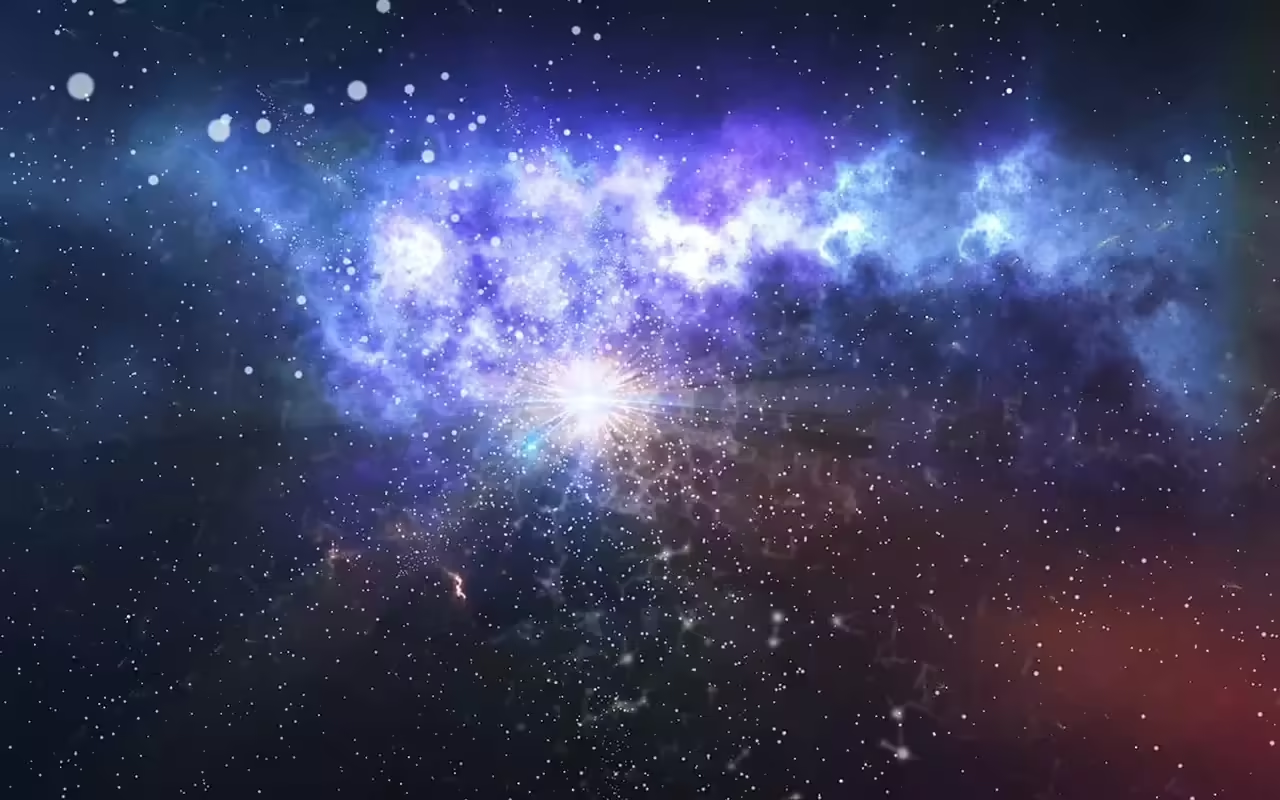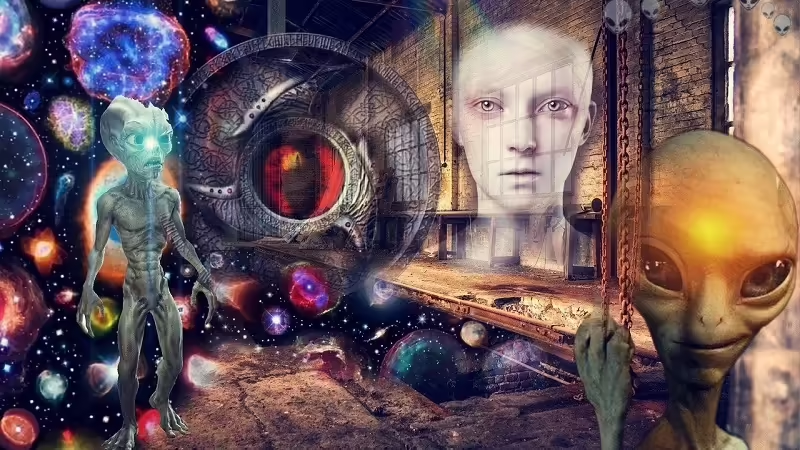
In the vastness of the universe, where darkness meets the expanse of space, intriguing cosmic phenomena emerge that challenge our conventional understanding of the cosmos. Among these enigmas, Dark Galaxies stand out as authentic cosmic mysteries, defying our preconceived notions about galactic formation and composition.
The Paradox of Stellar Absence:
Dark Galaxies, as their name suggests, are galactic structures that seemingly lack the bright presence of stars characteristic of traditional galaxies. This phenomenon poses an intriguing paradox: how is it possible that in the vast cosmos, where the light of stars illuminates the darkness, there exist galaxies that seem to defy this celestial pattern?
The answer to this question becomes a fascinating journey into understanding Dark Galaxies. Although, at first glance, these galaxies may appear empty, the reality is much more complex and subtle than we might initially perceive.
A Veil of Cosmic Mystery:
Dark Galaxies are shrouded in a veil of cosmic mystery, and astronomers embark on an intellectual challenge to decipher their secrets. Unlike conventional galaxies, which glow with the light of countless stars, these structures seem to hide their stellar wealth in a unique way.
Current theories suggest that Dark Galaxies could host stars in surprising quantities, but the light they emit is somehow absorbed, refracted, or otherwise eluded, making them invisible to our traditional observation instruments. This ability to conceal their stellar brilliance raises intriguing questions about the physical processes and extreme conditions that may be present in these enigmatic galaxies.
Technological Challenges:
Researching Dark Galaxies presents significant challenges for astronomers and space scientists. Current observation technologies rely on detecting light emitted by stars, and the presence of these seemingly opaque structures questions the effectiveness of our space exploration tools.
However, scientists are developing new technologies and approaches to overcome these challenges. Advanced telescopes and sensors, along with innovative observation techniques, are being designed to penetrate the veil of Dark Galaxies and reveal the truth behind their apparent lack of stars.
Cosmic Implications:
The study of Dark Galaxies not only offers a fascinating perspective on galactic diversity but may also have broader cosmic implications. Understanding the nature and composition of these galaxies could shed light on fundamental processes in the evolution of the universe and provide crucial information about the extreme conditions in the most distant and mysterious regions of the cosmos.
Discovery and Observation of Dark Galaxies: Chasing Cosmic Shadows
History of Discovery:
The history of discovering Dark Galaxies dates back to the early astronomical observations when astronomers began exploring the sky for celestial wonders. However, the recognition and understanding of these seemingly empty galaxies have been an evolutionary process that has benefited from significant advances in observation technology.
Although the first galaxy observations were made through telescopes in the 17th century, the identification and understanding of Dark Galaxies did not begin to emerge until the 20th century. Technological limitations of the time prevented astronomers from detecting galaxies that, at first glance, seemed to lack stars. It was only with the development of more advanced observation technologies and the expansion of space exploration that these enigmatic galactic structures began to reveal their secrets.
Methods and Observation Technologies:
Advanced Spectroscopy: One of the key tools for observing Dark Galaxies is advanced spectroscopy. This technique allows astronomers to analyze the light emitted by stars and other celestial objects, breaking it down into its spectral components. Spectroscopy helps identify the chemical composition of galaxies, even when the light is faint or somehow obscured.
Space Observatories: Observing from space has been a crucial advancement in the study of Dark Galaxies. Space telescopes like Hubble have enabled astronomers to avoid interference from the Earth’s atmosphere and capture clearer and more detailed images. This is especially important when dealing with galaxies with low luminosity, such as Dark Galaxies.
Detection of Non-Visible Radiation: Another fundamental strategy is the detection of non-visible radiation, such as infrared radiation and radio waves. Dark Galaxies may emit light in forms that are not easily perceptible to the human eye but are detectable through specialized technologies. These methods allow astronomers to identify stars and other galactic components that may be present but are invisible in the visible light spectrum.
Computational Simulations: In addition to direct observations, computational simulations play a crucial role in the study of Dark Galaxies. Computational models help scientists simulate the conditions in these galaxies and better understand the physical processes that could lead to the apparent lack of stars.
Distinctive Features of Dark Galaxies: Beyond the Apparent Absence of Stars
Dark Galaxies, although on the surface may seem devoid of stars, reveal distinctive features that set them apart profoundly from traditional galaxies. These singularities shed light on the complexity and hidden richness behind the apparent absence of stars.
Cosmic Camouflage: Unlike conventional galaxies, where starlight dominates the galactic landscape, Dark Galaxies have perfected the art of cosmic camouflage. While stars may exist in significant quantities within them, some unknown phenomenon or physical peculiarity allows these stars to elude our visual perception and conventional observations.
Emission of Invisible Waves: A defining feature is the emission of radiation in non-visible forms. Dark Galaxies may be rich in stars that primarily emit in the infrared spectrum or radio waves. These emissions, escaping visual detection, are crucial for identifying the presence of stars and other light sources in these enigmatic galaxies.
Abundance of Dark Matter: While all galaxies contain dark matter, in Dark Galaxies, the quantity of this mysterious matter could be particularly significant. The relationship between visible and dark matter could differ compared to conventional galaxies, adding an additional layer of complexity to their nature.
Extreme Environments: Dark Galaxies could exist in extreme cosmic environments, such as regions with high concentrations of cosmic dust or intense magnetic fields. These environments could affect the propagation of starlight, contributing to the apparent darkness of these galaxies.
Comparison with Traditional Galaxies:
Stellar Brightness: The most obvious difference between Dark Galaxies and traditional galaxies lies in stellar brightness. While conventional galaxies shine with the light of countless stars, Dark Galaxies may appear almost devoid of this distinctive feature at first glance.
Chemical Composition: Spectroscopic observations reveal differences in the chemical composition of Dark Galaxies compared to traditional galaxies. The presence of certain elements and compounds may vary, providing clues about the unique physical processes taking place in these enigmatic galaxies.
Dark Matter Density: Although all galaxies contain dark matter, the proportion and distribution of dark matter could differ between Dark Galaxies and conventional galaxies. This feature suggests possible variations in galactic formation and evolution.
Specific Structures: Some Dark Galaxies may exhibit specific structures, such as rings, gas jets, or regions of intense activity, which could be unique compared to traditional galaxies. These structures offer clues about the dynamic processes shaping these starless galaxies.
Current Theories on the Origin of Dark Galaxies: A Mystery in Scientific Debate
Dark Galaxies have maintained their position on the podium of cosmic mysteries, challenging expectations by presenting the apparent absence of stars. The explanation behind this phenomenon has been the subject of intense speculation and scientific debate, with various theories seeking to illuminate the origin of these enigmatic galactic structures.
Extreme Absorption by Cosmic Dust: One prominent theory suggests that stars within Dark Galaxies could be heavily obscured by the presence of extremely dense cosmic dust. This dust would act as an opaque veil, absorbing and blocking starlight before it can reach our telescopes. This explanation finds support in observations indicating the presence of large amounts of cosmic dust in these regions.
Emission Phenomena in Non-Visible Wavelengths: Another theory holds that stars within Dark Galaxies predominantly emit in non-visible wavelengths, such as infrared or radio waves. These emissions, although not detectable by conventional telescopes in visible light, could be fundamental to understanding the apparent darkness of these galaxies. Specialized space observatories in these wavelengths have begun to shed light on this aspect of the mystery.
Unique Environmental Conditions: Some theories suggest that Dark Galaxies could exist in unique and extreme environmental conditions, such as galactic regions with intense magnetic fields or extraordinary matter densities. These conditions could affect the propagation of starlight, contributing to the lack of visibility from Earth.
Dynamic Phenomena in Evolution: Another line of thought proposes that Dark Galaxies could be experiencing unique dynamic phenomena in their evolution. This could include events such as galactic mergers, intense gravitational interactions, or exceptional star formation processes. These events could lead to the temporary hiding of stars, thus explaining the apparent lack of stellar presence.
Abundant Presence of Dark Matter: Given the abundance of dark matter in the universe, some theories suggest that Dark Galaxies could have a unique composition with an unusually high proportion of dark matter compared to visible matter. This particular distribution could contribute to the lack of star visibility in these galaxies.
Dark Matter and its Enigmatic Role in Dark Galaxies: Beyond Stellar Absence
Density and Distribution of Dark Matter: The hypothesis is raised that in Dark Galaxies, the density and distribution of dark matter could be significantly different compared to traditional galaxies. Dark matter, not interacting directly with light, could be a dominant influence on the structure and dynamics of these galaxies, affecting the formation and evolution of stars in unexpected ways.
Dominance of Dark Gravity: Dark matter, believed to exert its influence mainly through gravity, could be playing a crucial role in the formation of starless galactic structures. Dark gravity could shape the orbits and movements of visible matter, thus affecting the distribution of stars in these enigmatic galaxies.
Dark Matter and Unique Environmental Conditions: Some theories suggest that the unique environmental conditions in which Dark Galaxies are found could be linked to the abundance of dark matter. These extreme environments could have fostered the formation of these unusual galaxies, where dark matter dominates gravitational interactions.
Dynamic Interactions and Galactic Mergers: Dark matter could be involved in dynamic events, such as galactic mergers or intense gravitational interactions, shaping the development of Dark Galaxies. These processes could explain both the apparent absence of stars and the presence of dark matter in significant quantities.
Implications for Understanding the Universe:
Galactic Diversity: The role of dark matter in the formation of Dark Galaxies highlights the incredible diversity of galactic structures in the universe. It shows that not all galaxies follow the same pattern of stellar formation and emphasizes the complexity and variability in cosmic evolution.
Limitations of Traditional Observation: Research on Dark Galaxies underscores the limitations of traditional observations based on visible light detection. These galaxies challenge our conventional tools and emphasize the need for innovative techniques, such as non-visible radiation detection, to fully understand the universe.
Reevaluation of Galactic Formation Theories: The role of dark matter in Dark Galaxies could lead to a reevaluation of existing theories on galactic formation. The influence of dark matter might require a revision of the models and concepts applied to cosmic evolution until now.







